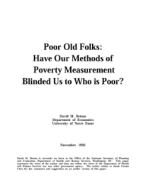Poor Old Folks: Have Our Methods of Poverty Measurement Blinded Us to Who is Poor?
Poor Old Folks: Have Our Methods of Poverty Measurement Blinded Us to Who is Poor?
Abstract
In this paper, we reexamine the consequences of the NAS Panel's recommendation after correcting for some recently discovered shortcomings in the Panel's imputation of medical out-of-pocket expenditures. The net result of using these new imputations is that there is a large increase in the poverty rate of the elderly. While the previous estimates showed that the poverty rate of the elderly did not significantly change under the Panel's recommendations, we now predict that their poverty rate will rise and approach the rate of children.
Before concluding that the conventional wisdom about the relative poverty of children and the elderly has been revised, we should note that the NAS Panel saw merit in adding a value for imputed rent to homeowners. The addition of imputed rent would reduce poverty rates for all groups where homeownership exists. Data from the 1991
American Housing Survey indicate that 39 percent of low income households own their own home but that if the household is headed by an individual 65 years old or older, the rate increases to 61 percent. Given that the low income elderly have an above average rate of homeownership, we would expect the addition of any imputed rent to
have a greater impact on the poverty rate of the elderly and to widen the relative gap between children and the elderly. The NAS Panel did not recommend considering the value of homeownership at this time because of the practical difficulties of implementing such a measure on either the CPS or SIPP data bases.
The impact of the revised MOOP imputations on other Panel findings was found to be small. We still find that if the Panel's recommendations were adopted, the poverty population in 1992 would be more likely to work full year, children would more likely live in families where both parents are present, and the poor would be less likely to
be receiving cash or in-kind benefits from the government, but more likely not to have health care insurance. We find that these results confirm the Panel's conclusion that its recommendations would not only restore internal consistency to our nation's poverty measure but also shine light on who is truly poor in the U.S. Moreover, as policies change in future years, the Panel's measure will show the effects -- positive or negative -- on the extent and composition of the nation's poor.
Others in Series
Working Paper
Working Paper
Working Paper




